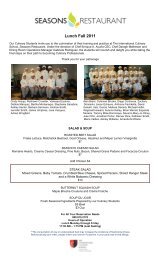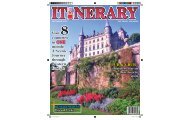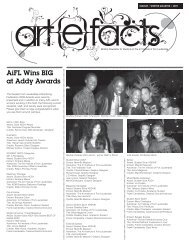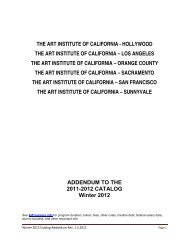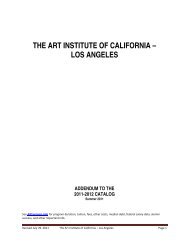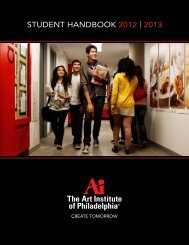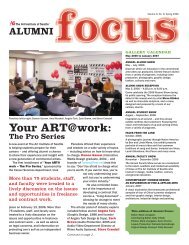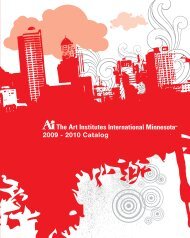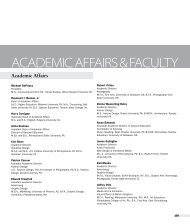2011-2013 CATALOG - The Art Institutes
2011-2013 CATALOG - The Art Institutes
2011-2013 CATALOG - The Art Institutes
You also want an ePaper? Increase the reach of your titles
YUMPU automatically turns print PDFs into web optimized ePapers that Google loves.
WORLD CIVILIZATIONS II SBS312<br />
4 Credits (General Education) - Prerequisites:<br />
SBS311 World Civilizations<br />
This course covers European history from the<br />
seventeenth century through post-World War<br />
II. It includes political, economic, and cultural<br />
development, such as scientific thought, the<br />
Enlightenment, the Industrial Revolution, and<br />
World Wars I and II.<br />
WORLD CONFLICT SBS325<br />
4 Credits (General Education) - Prerequisites: None<br />
Students will explore the concepts of cooperation,<br />
competition and conflict on a variety of levels. Specific<br />
areas of the world will be chosen to illustrate the effects<br />
of natural resources, religion, population, technology,<br />
and politics on human cooperation. Emphasis will be<br />
placed on analysis of current world conflict.<br />
WORLD CUISINE CU236<br />
3 Credits - Prerequisites: CU100 Fundamentals of Classical<br />
Techniques, CU110 Culinary <strong>The</strong>ory and Concepts<br />
This course emphasizes both the influences and<br />
ingredients that create the unique character of<br />
selected World cuisines. Students prepare, taste,<br />
serve, and evaluate traditional, regional dishes<br />
of Spain, Middle East, Turkey, Greece, Africa and<br />
India. Importance will be placed on ingredients,<br />
flavor profiles, preparations, and techniques<br />
representative of these cuisines.<br />
WORLD LITERATURE ENG320<br />
4 Credits (General Education) - Prerequisites: None<br />
This course expands and refines the objectives of<br />
English I. It emphasizes critical and logical thinking<br />
skills, reading comprehension, problem definition,<br />
research strategies, as well as analytical, evaluative,<br />
and/or persuasive writing.<br />
WRITING FOR INTERACTIVE<br />
DESIGN IM232<br />
3 Credits - Prerequisite: None<br />
This is a specialized writing course for interactive<br />
design. Students will learn the unique characteristics<br />
and techniques of internet, intranet, and other<br />
media writing and apply them to interactive media<br />
production. Students will also learn to conduct<br />
research for media writing projects.<br />
WRITING FOR MEDIA PD331<br />
3 Credits - Prerequisites: ENG100 English I<br />
This course is designed to introduce students to<br />
writing strategies for print and electronic media.<br />
Topics include media research; copyrighting; editing;<br />
advertising; and writing for print, television, video,<br />
animation, and interactive multimedia environments.<br />
WORLD CIVILIZATIONS II SBS312<br />
4 Credits (General Education) - Prerequisites:<br />
SBS311 World Civilizations<br />
This course covers European history from the<br />
seventeenth century through post-World War<br />
II. It includes political, economic, and cultural<br />
development, such as scientific thought, the<br />
Enlightenment, the Industrial Revolution, and<br />
World Wars I and II.<br />
ABOUT THE<br />
ART INSTITUTE<br />
OF PHOENIX<br />
History<br />
<strong>The</strong> <strong>Art</strong> Institute of Phoenix opened for business as<br />
an additional location of <strong>The</strong> <strong>Art</strong> Institute of Colorado<br />
(Denver) in September 1995, with classes beginning<br />
in January 1996. <strong>The</strong> initial class was made up of 45<br />
students across the four programs with a total staff<br />
and faculty of 17.<br />
<strong>The</strong> associate degree in Culinary <strong>Art</strong>s received<br />
American Culinary Federation (ACF) accreditation in<br />
February of 2005. In February 2006, the Bachelor of<br />
<strong>Art</strong>s in Interior Design degree received Council for<br />
Interior Design Accreditation (CIDA). In March 2006,<br />
<strong>The</strong> <strong>Art</strong> Institute of Phoenix was granted status as a<br />
freestanding institution by the Accrediting Council for<br />
Independent Colleges and Schools (ACICS).<br />
In February 2010, the Associate of Applied Science<br />
in Baking & Pastry <strong>Art</strong>s, the Associate of Applied<br />
Science in Culinary <strong>Art</strong>s, and the Bachelor of <strong>Art</strong>s<br />
in Culinary Management each received five-year<br />
grants of accreditation through American Culinary<br />
Federation Education Foundation Accrediting<br />
Commission (ACFEFAC).<br />
<strong>The</strong> <strong>Art</strong> Institute of Phoenix is a subsidiary of <strong>The</strong> <strong>Art</strong><br />
<strong>Institutes</strong> International, Inc., which is a subsidiary of<br />
Education Management Corporation. In addition, <strong>The</strong><br />
<strong>Art</strong> Institute of Phoenix has the following branches:<br />
• <strong>The</strong> <strong>Art</strong> <strong>Institutes</strong> International SM - Kansas City<br />
• <strong>The</strong> <strong>Art</strong> Institute of Wisconsin<br />
Facilities<br />
In 1995, <strong>The</strong> <strong>Art</strong> Institute of Phoenix opened at<br />
2233 West Dunlap Avenue, in Phoenix, Arizona.<br />
Near the Black Canyon Freeway, the modern<br />
building promotes a positive learning environment.<br />
Occupying approximately 78,655 square feet of<br />
a 92,000 square- foot building, the interior was<br />
designed with creative students in mind. Spacious<br />
classrooms, and fully equipped studios and labs<br />
offer a positive working atmosphere. Three modern<br />
kitchens, with ample windows offering broad<br />
sweeping views, provide a creative environment for<br />
the culinary student.<br />
Demographics<br />
According to regulations published by the<br />
Department of Education, as part of the Higher<br />
Education Act, we have provided the chart below<br />
demonstrating the diversity of our student body as<br />
of Fall 2009.<br />
<strong>The</strong>se statistics below include all enrolled, full-time<br />
students for the main campus and any branch locations:<br />
Total Undergraduate<br />
Enrollment<br />
Number of<br />
Students<br />
1,287 n/a<br />
Gender<br />
Male 624 48%<br />
Female 663 52%<br />
Percentage of<br />
Student Body<br />
Race/Ethinicity<br />
(Self-Identified)<br />
Hispanic/Latino<br />
Hispanic/Latino<br />
94<br />
94<br />
7%<br />
7%<br />
American Indian or<br />
American Indian or<br />
Alaska<br />
Alaska<br />
13<br />
13<br />
1%<br />
1%<br />
Asian<br />
Asian<br />
16<br />
16<br />
1%<br />
1%<br />
Black or African<br />
Black or African<br />
American<br />
American<br />
57<br />
57<br />
4%<br />
4%<br />
Native American<br />
Native American<br />
Hawaiian or Other<br />
Hawaiian or Other<br />
n/a<br />
n/a<br />
n/a<br />
n/a<br />
White<br />
White<br />
304<br />
304<br />
24%<br />
24%<br />
Two or More Races<br />
Two or More Races<br />
n/a<br />
n/a<br />
n/a<br />
n/a<br />
Non Resident Alien<br />
Non Resident Alien<br />
n/a<br />
n/a<br />
n/a<br />
n/a<br />
Race or Ethnicity<br />
Race or Ethnicity<br />
unknown<br />
unknown<br />
803<br />
803<br />
62%<br />
62%<br />
Federal Pell Grant<br />
Federal Pell Grant<br />
Recipients<br />
Recipients<br />
(2008 cohort)<br />
(2008 cohort)<br />
58<br />
58<br />
42%<br />
42%<br />
GETTING<br />
THE MOST<br />
FROM YOUR<br />
EDUCATION<br />
Our role is to provide educational services to<br />
help you develop your potential. An <strong>Art</strong> Institute’s<br />
education is not something we do to our students.<br />
Instead, it is a process where we learn and explore<br />
with you. We cannot simply hand you skills and<br />
knowledge. You must be a full partner in this<br />
interactive learning process.<br />
At <strong>The</strong> <strong>Art</strong> Institute of Phoenix, you have the<br />
opportunity to become part of a vibrant energetic<br />
learning community, where you are supported and<br />
encouraged to do your best. It’s a community where<br />
we celebrate diversity. It’s a community bound by<br />
mutual respect for individuality and creativity.<br />
Your responsibilities as a student of <strong>The</strong> <strong>Art</strong> Institute<br />
of Phoenix require that you:<br />
• Meet deadlines<br />
• Attend class<br />
• Arrive on time<br />
• Make use of faculty and staff<br />
• Ask questions<br />
Reading and understanding the policies in this<br />
catalog, the Enrollment Agreement, the Student<br />
Handbook, and any policies subsequently provided<br />
to you, are also your responsibility.<br />
Our faculty and staff are here for you. If you have any<br />
questions, don’t hesitate to ask!<br />
STATEMENT OF STUDENT<br />
COMMITMENT<br />
• I perceive myself as artistic and creative.<br />
• I believe in myself and am committed to the<br />
work I do.<br />
• I demonstrate ethics in the work I produce.<br />
• I possess clear career goals.<br />
• I choose to attend regularly and participate<br />
actively in learning activities.<br />
THE ART INSTITUTE OF PHOENIX <strong>2011</strong>-<strong>2013</strong> COURSE <strong>CATALOG</strong> 53



